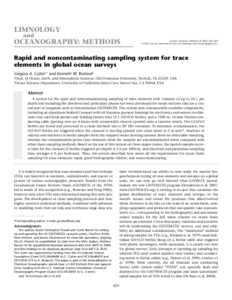| dc.contributor.author | Cutter, Gregory A. | |
| dc.contributor.author | Bruland, Kenneth W. | |
| dc.date.accessioned | 2020-03-09T21:12:27Z | |
| dc.date.available | 2020-03-09T21:12:27Z | |
| dc.date.issued | 2012 | |
| dc.identifier.citation | Cutter, G.A. and Bruland, K. W. ( 2012) Rapid and noncontaminating sampling system for trace elements in global ocean surveys, Limnology and Oceanography: Methods, 10, pp.425-436. DOI::10.4319/lom.2012.10.425. | en_US |
| dc.identifier.uri | http://hdl.handle.net/11329/1228 | |
| dc.identifier.uri | http://dx.doi.org/10.25607/OBP-743 | |
| dc.description.abstract | A system for the rapid and noncontaminating sampling of trace elements with volumes of up to 36 L per depth and including the dissolved and particulate phases has been developed for ocean sections that are a crucial part of programs such as International GEOTRACES. The system uses commercially available components, including an aluminum Seabird Carousel with all titanium pressure housings for electronics and sensors to eliminate zinc sacrificial anodes and holding twenty‐four 12 L GO‐FLO bottles, and a 7500 m, 14 mm Vectran conducting cable (passing over an A‐frame with nonmetallic sheave) spooled onto a traction winch. The GO‐FLO bottles are stored and processed in a clean lab built into a 20' ISO container. To minimize contamination, the GO‐FLO bottles are triggered when the carousel is moving upward into clean water at 3 m min−1. Analyses of salinity and nutrients in bottle samples from the stopped versus moving carousel show no detectable smearing, whereas the contamination‐prone trace elements show the samples are uncontaminated when compared with other clean sampling methods. Based on the use of this system on three major cruises, the launch‐sample‐recover time for the carousel (2 bottles triggered per depth) is 1 h per 1000 m, and dissolved and particulate sampling time averages 6 h per hydrocast. Thus, the system described here meets all the requirements for ocean basin sampling for trace elements: rapid, good hydrographic fidelity, and noncontaminating. | en_US |
| dc.language.iso | en | en_US |
| dc.rights | Attribution 4.0 International | * |
| dc.rights.uri | http://creativecommons.org/licenses/by/4.0/ | * |
| dc.subject.other | Sea Bird carousel | en_US |
| dc.subject.other | GO FLO bottle | en_US |
| dc.subject.other | Trace elements | en_US |
| dc.subject.other | GEOTRACES | en_US |
| dc.subject.other | Water sampler | en_US |
| dc.title | Rapid and noncontaminating sampling system for trace elements in global ocean surveys. | en_US |
| dc.type | Journal Contribution | en_US |
| dc.description.refereed | Refereed | en_US |
| dc.format.pagerange | pp.425-436 | en_US |
| dc.identifier.doi | 10.4319/lom.2012.10.425 | |
| dc.subject.parameterDiscipline | Parameter Discipline::Chemical oceanography | en_US |
| dc.bibliographicCitation.title | Limnology and Oceanography: Methods | en_US |
| dc.bibliographicCitation.volume | 10 | en_US |
| dc.description.sdg | 14.A | en_US |
| dc.description.eov | Particulate matter | en_US |
| dc.description.maturitylevel | TRL 9 Actual system "mission proven" through successful mission operations (ground or space) | en_US |
| dc.description.bptype | Standard Operating Procedure | en_US |
| obps.contact.contactname | Gregory Cutter | |
| obps.contact.contactemail | gcutter@odu.edu | |
| obps.resourceurl.publisher | https://aslopubs.onlinelibrary.wiley.com/doi/abs/10.4319/lom.2012.10.425 | en_US |
 Repository of community practices in Ocean Research, Applications and Data/Information Management
Repository of community practices in Ocean Research, Applications and Data/Information Management

